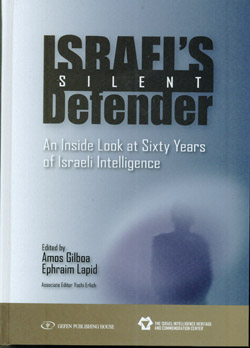Israel’s Silent Defender: An Inside Look at Sixty Years of Israeli Intelligence, edited by Amos Gilbo and Ephraim Lapid, Gefen Publishing House, Jerusalem, 2012, 385 pages including appendices,
ISBN 978-965-229-528-6.
By Donald H. Harrison

 SAN DIEGO–This collection of essays by members of Israel’s intelligence establishment has been thoroughly vetted to make sure nothing therein provides any secrets to Israel’s enemies.
SAN DIEGO–This collection of essays by members of Israel’s intelligence establishment has been thoroughly vetted to make sure nothing therein provides any secrets to Israel’s enemies.
Nevertheless for lay readers, it is a revealing look into the shadowy world of spies and military planning. It honestly assesses some of the blunders Israel made in its various wars and skirmishes with implacable enemies from the 1948 Independence War to the present. It also gives credit where it is due.
Because of the discussion lately about the possibility of Israel carrying out an attack on Iran’s nuclear facilities, two essays of particular interest are those that look back to 1981 when the Israeli Air Force successfully bombed and put out of commission the nuclear reactor that Saddam Hussein was having built for Iraq.
One essay is by Maj. Gen. Aviezer Yaari, former head of the Production and Analysis Division of Israel Defense Intelligence (IDI). He wrote that before any attack could be mounted, the intelligence community needed to complete three major tasks: 1) Monitor the progress of the nuclear reactor toward the capability of making nuclear weapons. 2) Determine whether the reactor could be prevented from working, or retarded in its operation, by a military strike. 3) Determine what military obstacles would lie in the path of attacking Israeli jets.
As the Israelis weighed their options, five major points were made in opposition to conducting such an attack, and seven in favor of the attack.
Opposition arguments suggested that a) the attack would engender world hostility to Israel, especially if it caused any nuclear material to be released into the atmosphere; b) that Israel would be seen as scuttling the continuing peace process with Anwar Sadat’s Egypt; c) that the bombing of the reactor might unite the Arab world against Israel; d) that the United States and other western democracies might impose sanctions against Israel, e) and that destroying the reactor might only firm up Iraq’s resolve to do everything in its power to build another one.
Arguments in support of the Iraqi mission said a)the bombing should be done before the nuclear plant could produce the bombs, and that time was of the essence; b) Third-party nationals such as French advisors had left Iraq upon the outbreak of the Iraq-Iran War; c) A solid defense system had not been installed around the reactors; d) Iran already had tried to wipe out the reactor, but was unsuccessful, so the Israeli strike might seem to be one from Iran; e) the strike was unlikely to unite the Arab world, despite the rhetoric; f) while the U.S. would respond with harsh rhetoric, genuine sanctions against Israel were unlikely. g) Even if the strike only delayed Iraq’s acquisition, it bought time — and who knows what could happen in time.
In the latter regard, General Yaari pointed out that while Saddam renewed his efforts to build a nuclear reactor, they came to naught 11 years later when his nuclear projects were destroyed by the United States in the first Gulf War of 1991. Had Israel not set Iraq’s nuclear program back, it might have been a different story.
A companion essay was written by Reserve Lt. Col. Shamai Golan, who was the air intelligence officer for the attack operation. He said that the military issues around an attack came down to these three issues: 1) what is known about the construction materials and architecture of the nuclear reactor; what is the best way to destroy it? 2) How was it defended? 3) What route could Israeli jets take to get there? Over Jordan, over Turkey or over Saudi Arabia?
Of these issues, the most difficult for the intelligence service to answer was what route to take. Eventually, it was decided that the planes should fly at a low altitude, to prevent tracking, over northern Saudi Arabia on a 90-minute route to the reactor, south of Baghdad. But was that possible without being spotted? And if it weren’t, would Saudi Arabia react quickly enough to notify Iran or Iraq that the Israeli jets were on the way?
The adeptness of Saudi Arabia’s warning system was tested over months of planning by Israeli flights that surreptitiously crossed the Saudi border. Radar stations, military posts, even high tension wires were spotted and mapped. “Need to know” security kept the number of people who were aware of what Israel was contemplating to a minimum.
Nevertheless, en route to Iraq, the jets were spotted flying east by no less a figure than King Hussein of Jordan, who was sailing in the Gulf of Aqaba. But the Jordanian government did not pass on any message to the Iraqis, and when the planes reached their destination, it was a complete surprise.
There are, of course, many differences between the Iraqi situation of more than three decades ago and the Iranian situation of today. But, in helping lay people to imagine the kinds of calculations, Israeli strategists must weigh, this book is obviously quite helpful.
*
Harrison is editor of San Diego Jewish World. He may be contacted at donald.harrison@sdjewishworld.com
The King was FLYING, not sailing.
The IDF stepped up and spoofed even the King into thinking his words were reaching Amman.
That’s an old story.
Cheers.